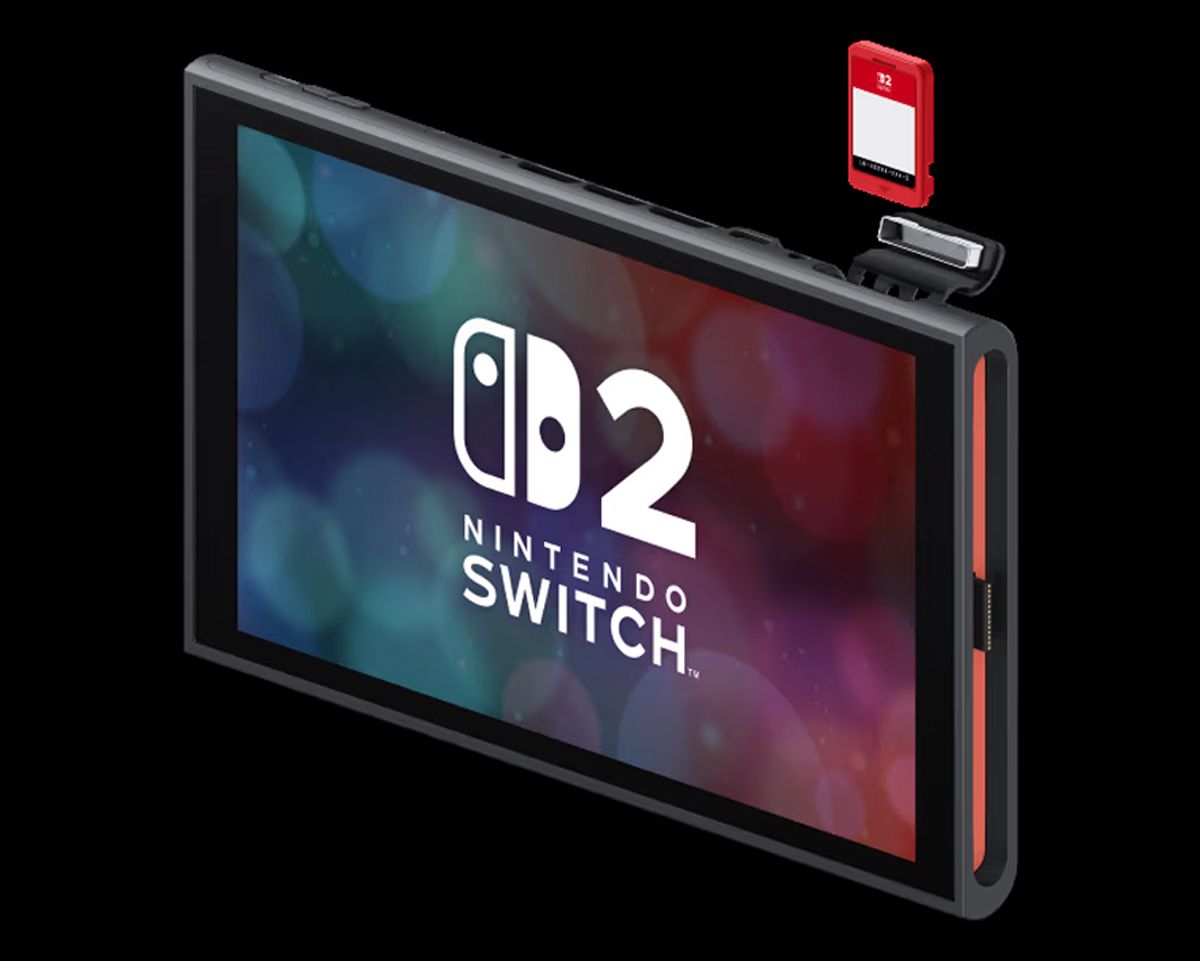One of the biggest changes of Nintendo’s generational leap to the Switch 2 is the new console’s game carts. Not the aesthetic shift—they’re now red, to differentiate them from the original Switch’s slate gray ones—but rather that, in many cases, they won’t contain a game at all.
While all first-party Nintendo games are currently expected to be released on-cart, other publishers may choose to release their Switch 2 titles on “game-key cards.” These have no actual game data on them, instead serving as a physical license to access and play a digital version of a game. Per Nintendo, after players insert the game-key card into their console, they’ll be prompted to download the associated game. An internet connection will be required to download the game and for any online features, but otherwise, game-key card titles will be playable offline as normal, so long as that physical cartridge is inserted, its presence serving as a software authentication tool.
It’s a direction that has proven controversial with both fans and some developers (former Assassin’s Creed and Far Cry lead Alex Hutchinson said, “I think it’s sort of lame,” while Nightdive Studios CEO Stephen Kick said the move is “a little disheartening”) and could be confusing for consumers, despite Nintendo’s plans to clearly mark the packaging of game-key card titles. However, the move does have several positives—and it may just be a harbinger of the future for the entire games industry.
Better Than Literally Nothing
Probably the biggest plus point to game-key cards is that they’re an improvement on the current equivalent, which is … nothing at all. Switch cartridges are a proprietary storage format, which means they can be more expensive, per GB of storage, to release games on than mass-market media. As a result, several game publishers sell titles in a “code in a box” format—entirely empty Switch cases with a single-use, digital download code to redeem on the Nintendo eShop.
While these sorts of releases ostensibly fill a market gap, giving real-world retailers a product to put on shelves and, even for online sellers, providing some form of physical object to send to customers—useful to give out as gifts, for instance—they’ve always been an odd category. Collectors typically want an actual game on their shelves, while those unbothered by a permanent library would likely be browsing a digital-only storefront in the first place. Either way, once that code has been redeemed, the customer is left with an empty plastic case with no purpose and no secondary market value. Code-in-a-box releases are ultimately a waste of materials to produce and dispose of, the remnants likely destined for landfill.
Game-key cards go some small way to solving these problems. For collectors, they’ll have something in the case lining their shelves, making their collections tangible, while more casual players can take a chance on titles they’re unsure of. That’s because the carts won’t be tied to user accounts—anyone with the cart downloads their own copy of the game. Because the cartridge itself is the key, you’ll be able to lend out, sell, or trade-in game-key cards as easily as carts for previous console generations, and only whoever physically possesses it will be able to play.
There is still a convenience factor to consider, as you’ll need to have that cart inserted into your Switch 2 to play the game, unlike entirely digital purchases, but it stands to be a far more versatile and arguably consumer-friendly approach than those one-time codes. We’ll have chance to see which format players prefer with the first wave of Switch 2 titles, as titles like EA’s Split Fiction sticks with the code-in-a-box approach.
The biggest concern surrounding game-key cards, particularly for collectors, is likely to be longevity. A 40-year-old NES game cart can still be played on a working console—will the same be possible for a Switch 2 game in 2065? A game-key card would, presumably, still authenticate an already installed game to run (in this hypothetical, your Switch 2 console is still intact and working decades from now, too), but if the servers aren’t running anymore to enable downloading the linked software in the first place, that cart would be useless—just more e-waste.
However, Switch 2 games could still be available to download for a long time. There’s precedent here—although the Wii virtual store has long since been deactivated for new purchases, players can still download their existing purchases. Similarly, 3DS games and even update data can also be redownloaded, more than a year after its online store was turned off.
Those might represent different scenarios, given digital purchases on those earlier platforms were tied to the specific piece of hardware. (For example, Nintendo says you need “the same Wii console you used to originally download the game” to redownload.) Nintendo has since adopted an account-based structure for Switch 1, linking purchases to the user who bought them, and transferable to a new console.
That leaves game-key cards in a sort of limbo, unaffiliated with either hardware or user. That could throw up unforeseen hurdles in the much longer term—there’d be no way to predict when a game-key card in the wild would be plugged in and need a game to download—but based on Nintendo’s track record for supporting digital games on retired hardware, there doesn’t appear to be anything to be immediately concerned about, especially when backward compatibility on Switch 2 is looking like a priority.
It is fair to wonder why, if publishers are releasing a game on a cart at all, they wouldn’t just put the game on there anyway. There are likely some practical reasons to explain this, though. Like the original Switch, the proprietary format again means cards that include flash memory to store game data on are more expensive to produce, so it’s a way to keep production costs down. Don’t expect a consumer benefit from that, but it will make business sense, somewhere.
Pushing the Limit
Then there’s the matter of storage limits. Switch 2 carts can hold a maximum of 64 GB of data—double the total internal capacity on the original Switch console itself, but still pretty meager compared to game sizes now. Some studios have performed some dark compression magic—CD Projekt Red has crammed Cyberpunk 2077: Ultimate Edition, which weighs in at over 70 GB on PC, down to just 56.8 GB on Switch 2 to be one of the few third-party titles shipping with the full game data on the card—but other games may be larger than an actual Switch 2 cart could hold.
Games exceeding the capacity of physical media isn’t unique to Nintendo. The recent PS5 release of Indiana Jones and the Great Circle has only 20 GB on-disc, which sounds paltry when you consider a PS5 disc can hold up to 100 GB of data, but not when the installed size of the game is over 120 GB. Bethesda’s Doom: The Dark Ages, too, ships with only 85 MB of data on the game disc (although there, the full install potentially could fit on a disc). However, like Nintendo’s game-key cards, both of these prompt players to download the actual game in full.
It’s worth remembering that even when a game’s data is on a disc or cart at launch it’s rarely the full and final version of a game nowadays. Even for single-player titles, day-one patches, updates, bug fixes, and bonus DLC can drastically change a game after release (which raises philosophical questions for preservationists too—which iteration do you save?) and require more storage space. As data demands continue to balloon, we may have reached the limit of physical storage for video games, so game-key cards (or discs) may be the best we get.
In that light, Nintendo providing any material release at all is actually a small win for fans of physical media, especially given how boxed-game sales have absolutely cratered. Industry analyst Mat Piscatella highlighted in January 2025 that spending on physical games in the US has halved since 2021 and is down 85 percent on a 2008 high. In the UK, a recent study by trade body UKIE found that physical sales accounted for just 4 percent of total spend in 2024 and represented a 34 percent fall year on year. Increasingly, consumers are choosing to go digital even when a physical option exists.
Even collector’s editions, those bastions of physical media, are now abandoning physical copies of their game. Sony’s upcoming Ghost of Yōtei costs $250 for the premium package and still provides just a download code for the game itself. Physical releases are becoming an afterthought.
These shifts in consumer and corporate behavior absolutely raise questions about game preservation and long-term access to the games we play, but those questions apply across the whole industry. As it stands, Nintendo’s game-key cards may end up being physical gaming media’s last gasp—even though they don’t have a game on them at all.




